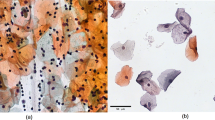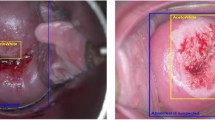Abstract
COMPUTER programmes which process data obtained by scanning 35-mm films of individual cervical cells are being tested in an attempt to obtain a quantitative definition of the differences between normal and malignant cells. The scanning instrument is of an electro-optical nature and has a digital output1,2. It scans the photographic film in an array of points with each point yielding a number (between 0 and 128) the value of which depends on the emulsion density. The scan resolution can be varied from 4 lines each with 4 points to 256 lines each with 512 points. A typical single line scan (with 128 points) across a cervical cell nucleus is seen in Fig. 1. Normally these data are punched out automatically on paper tape, suitable for input to a Ferranti Sirius computer.
This is a preview of subscription content, access via your institution
Access options
Subscribe to this journal
Receive 51 print issues and online access
$199.00 per year
only $3.90 per issue
Buy this article
- Purchase on Springer Link
- Instant access to full article PDF
Prices may be subject to local taxes which are calculated during checkout
Similar content being viewed by others
References
Ward, A., and McMaster, G. W., p. 428 of this issue of Nature.
McMaster, G. W., “A Technique for the Digital Scanning of Normal and Malignant Cervical Cells”, paper presented at the Northern Cancer Res. Group's Conf., Sheffield, during April 8–9, 1965.
Author information
Authors and Affiliations
Rights and permissions
About this article
Cite this article
MCMASTER, G. Computer Recognition of Cervical Cell Nuclei. Nature 208, 485–486 (1965). https://doi.org/10.1038/208485a0
Issue Date:
DOI: https://doi.org/10.1038/208485a0
Comments
By submitting a comment you agree to abide by our Terms and Community Guidelines. If you find something abusive or that does not comply with our terms or guidelines please flag it as inappropriate.



